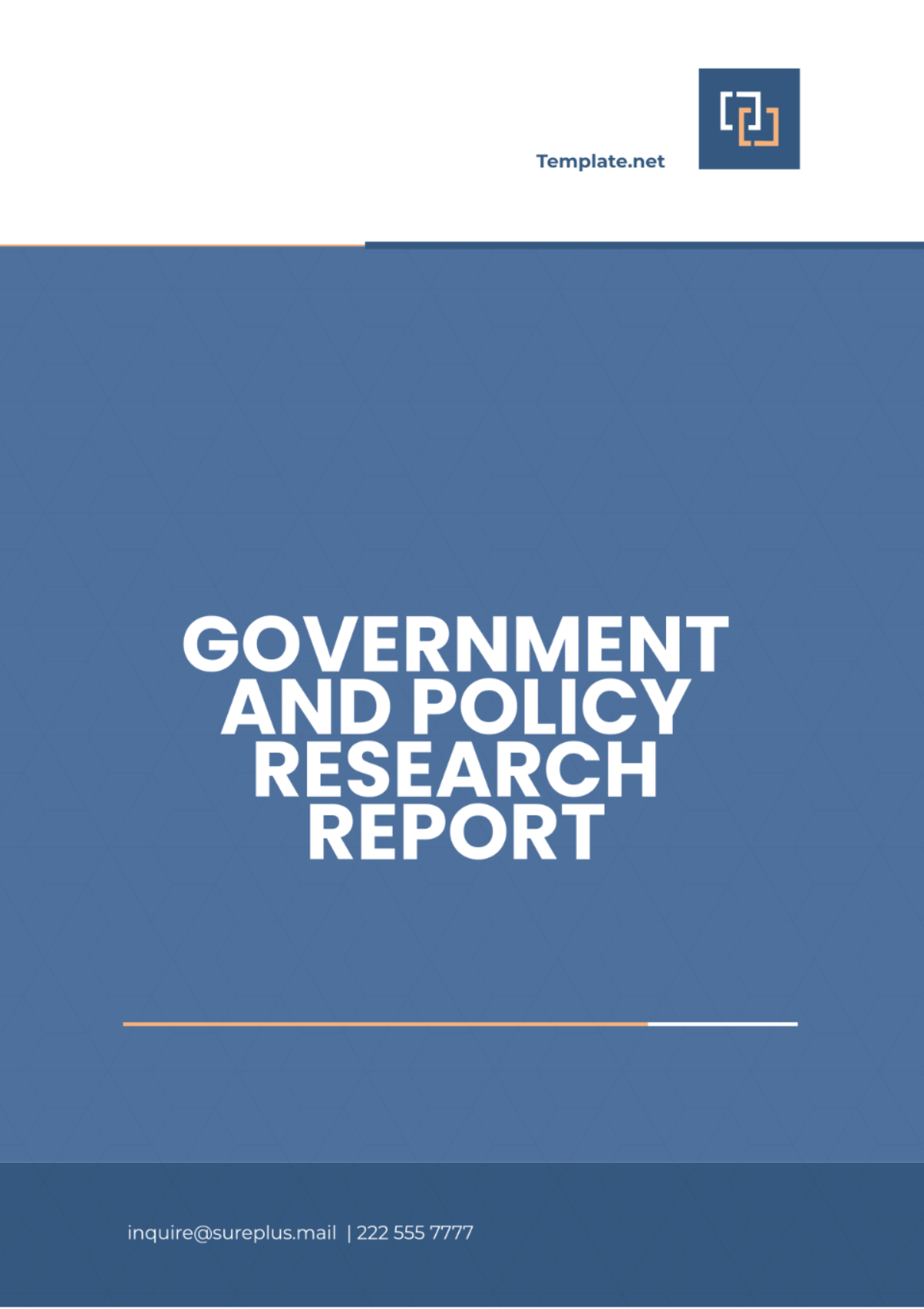Free Government and Policy Research Report

Prepared by | [Your Name] |
Date | September 10, 2060 |
I. Executive Summary
This report analyzes the "Green Energy Transition Act of 2060," a policy initiative aimed at reducing greenhouse gas emissions by transitioning the national energy grid to renewable sources. Conducted in 2061, this research assesses the policy’s initial impacts on energy infrastructure, economic growth in the renewable sector, and public perception. Key recommendations include enhancing funding for rural solar projects, implementing additional tax credits for green technology, and improving public outreach to boost support.
II. Introduction
A. Background
The Green Energy Transition Act was enacted in January 2060 to reduce national carbon emissions by 45% by 2070. This ambitious plan focuses on shifting the energy grid to rely on wind, solar, and geothermal sources. However, early analysis is needed to assess the policy’s effectiveness and identify any immediate challenges.
B. Objectives
Assess the policy's economic impact on traditional and renewable energy.
Assess public support and perception.
Identify challenges in the policy’s implementation to inform future amendments.
C. Scope
This report evaluates the impact of the Green Energy Transition Act on both urban and rural communities across the United States, with a particular focus on data from the initial implementation years, 2060–2061.
III. Methodology
Data Collection: Data was gathered from national surveys on energy preferences, interviews with local government officials, and field observations in five pilot states (California, Texas, New York, Ohio, and Florida) from 2060 to 2061.
Data Analysis: Statistical models analyzed survey data on public perception and economic impact, while policy documents were reviewed to understand legal frameworks.
Stakeholder Engagement: Consultations with key stakeholders including renewable energy companies, utility providers, and environmental advocacy groups took place in mid-2061 to provide insight into the policy’s initial challenges.
IV. Findings
A. Policy Impacts
Early data indicates a 15% reduction in fossil fuel usage across pilot states within the first year of implementation. Solar and wind energy outputs increased by 20% in these regions from 2060 to 2061, resulting in lower emissions and an estimated 10% boost in jobs within the green energy sector.
B. Public Response
Surveys conducted between 2060 and 2061 show that 72% of urban respondents and 60% of rural respondents support the policy, although concerns were noted regarding potential energy cost increases in rural areas. The highest support was observed among individuals aged 18–35, with 80% in favor of accelerating the transition.
C. Comparative Analysis
The United States’ approach under the Green Energy Transition Act closely aligns with similar policies enacted in the European Union between 2055 and 2060, which have shown a 25% reduction in emissions in the first five years. However, differences in energy infrastructure and public opinion highlight the need for targeted adjustments in the U.S. strategy.
V. Analysis and Discussion
A. Strengths
Economic Growth: Significant job creation in the renewable energy sector has spurred economic growth, with an estimated 300,000 jobs added by 2061.
Public-Private Collaboration: Successful partnerships between government and private companies have improved the policy’s reach and effectiveness, particularly in urban areas.
B. Challenges
Resource Allocation: Rural communities report delayed infrastructure upgrades, leading to disparities in renewable energy access.
Public Concerns: Although broadly supportive, some rural residents are concerned about potential increases in energy prices due to the initial cost of infrastructure upgrades.
C. Future Considerations
To maintain momentum, the U.S. government should consider:
Increasing subsidies for rural renewable energy projects starting in 2062.
Enhancing community engagement programs to address public concerns and foster a deeper understanding of the long-term benefits.
VI. Recommendations
Increase Budget Allocations for Rural Solar Projects: An additional $500 million should be allocated annually from 2063 to expand solar and wind infrastructure in rural areas, ensuring equal access to renewable energy.
Implement Additional Tax Credits for Green Technology: Introduce new tax incentives for households and businesses that adopt green technologies, aiming to reduce energy costs and drive public support, particularly in lower-income regions.
Enhance Public Awareness Campaigns: Launch targeted campaigns in rural communities by mid-2062 to increase understanding of the policy’s benefits, aiming for 85% public support by 2065.
Establish a Comprehensive Monitoring Framework: Implement a robust monitoring system to track emissions reductions and job growth, with biannual reports starting in 2061 to assess progress toward the 2070 emissions target.
VII. Conclusion
The Green Energy Transition Act of 2060 represents a critical step toward sustainability in the U.S. This report’s findings emphasize the importance of inclusive policy adjustments and targeted investments to support rural and underserved communities. By addressing the identified challenges and capitalizing on current strengths, the U.S. can achieve its emissions goals and lead in global environmental reform.
VIII. References
Primary Sources: The Green Energy Transition Act of 2060, United States Environmental Protection Agency (EPA) reports, and National Renewable Energy Laboratory publications.
Secondary Sources: Peer-reviewed journals on sustainable energy policy, comparative analyses from the European Union's energy transition data, and public survey data from Gallup Polls conducted in 2060 and 2061.
- 100% Customizable, free editor
- Access 1 Million+ Templates, photo’s & graphics
- Download or share as a template
- Click and replace photos, graphics, text, backgrounds
- Resize, crop, AI write & more
- Access advanced editor
Template.net's Government and Policy Research Report Template is a polished, editable, and customizable tool tailored for policy analysts and governmental research. This template includes sections for policy objectives, research data, and recommendations. It’s ideal for presenting evidence-based analysis in a clear, professional format. Editable in our Ai Editor Tool, it simplifies complex data presentation for public and private sector use.
You may also like
- HR Policy
- Restaurant Policy
- Company Policy
- Accounting Policies and Procedures
- Website Policy
- Privacy Policy
- Safety Policy
- School Policy
- IT and Software Policy
- Law Firm Policy
- Construction Policy
- Interior Design Policy
- Travel Agency Policy
- Education Academic Policy
- Security Policy
- Real Estate Policy
- Expense Policy
- Software Policy





























